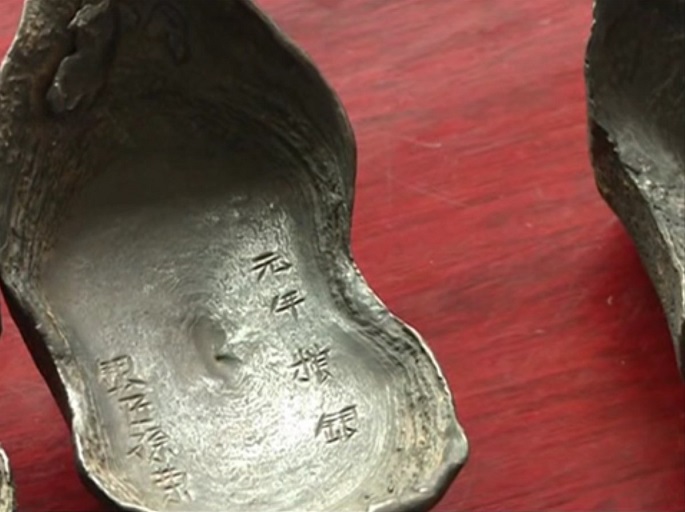One story passed on from generations to generations tells about ships--too many for one’s fingers to count--set on fire during a battle as they sail a river heading to an unknown destination. As they burn, the river swallowed them up--together with the gold and silver items they carried.
Another version--but still referring to the same ill-fated trip across the same river--narrates that as enemy ships chase and attack a group of fleeing rebels, their leader ordered his men to dump into the river the gold and other precious items stored in their ships.
Those who share this ancient tale would go into details by disclosing the setting of this lore: 17th-century China--the later part of the Ming Dynasty (1368-1644)--in a river called Min Jiang (Min River) in central Sichuan Province.
They likewise never fail to identify the central character of the story: Zhang Xianzhong, a name uttered in history classes and perhaps cursed upon by those who encountered him or read about him.
Now how about the gold and the silver sinking-dumping part?
This 21st century, that legend became a historical fact.
When Legends Become True
It seems to all start 11 years ago--sometime in 2005.
During an irrigation project at Minjiang River in the ancient town of Jiangkou in Pengshan District, Sichuan Province, one of the workers--a local farmer named Yang Fuhua--found a silver ingot, according to the Global Times.
News about the discovery spread like wildfire, and the quest have since ensued for what people believe to be Zhang Xianzhong’s fabled treasure.
According to a Dec. 2010 report by the same news site, every day, some 300 people would look for it at the said river.
That same year, the government named the Pengshan section of the river--where Zhang’s ships capsized--as Jiangkou Chenyin Historic Site.
In Dec. 2015, ten archaeologists confirmed the authenticity of the items found in Minjiang River in 2005 and 2011, reported China.org.
And, lo and behold, some of them serve as proofs that indeed, gold and silver items went down with Zhang’s ship and convoy in that river more than 350 years ago.
Some of the silver ingots found have inscriptions revealing information pertaining to his army of bandits; moreover, a gold plate engraved with 29 Chinese characters indicates a decree of sorts by Zhang himself.
Weighing 730 grams and measuring 12 centimeters long and 10 centimeters wide, the gold plate was classified as a Grade One relic.
Locals As Modern-day Bandits?
Liao Mingfang, the party secretary of Shuangjiang Village at the time of the interview, said to the Global Times that officials from Pengshan Cultural Relic Bureau would ask people to quit the search at the river to no avail.
Well, who would stop when something as valuable as a Ming Dynasty relic could be sold at a sum way higher than what a farmer could make from just toiling the land?
Liao said that a piece of jewelry would fetch as high as 50,000 yuan.
That amount, by the way, also happens to be the maximum fine the Chinese government can impose on anyone “concealing or refusing to hand over cultural relics discovered,” based from Article 74 of “Law of the People’s Republic of China on Protection of Cultural Relics.”
In April 2015, under the Ministry of Public Security, 3,000 top police officers conducted investigations. On their own version of treasure hunt, they unearthed something bad: illegal relic traders operate in more than 10 cities and provinces, reported Caixin.
In 2014, Meishan police learned about unauthorized nighttime excavations at Minjiang River. From the said investigations, it was learned that this 2014 incident was part of the activities of the illegal traders.
Leader, Looter, Murderer—A Glimpse of Zhang Xianzhong
A former soldier of the Ming army born from a poor family in Shaanxi Province, Zhang Xianzhong (1606-1647) formed and led his own group of bandits and revolted against the Ming government.
Zhang not only opposed the authorities of his time and raided territories--killing government troops and civilians while doing them--he also pillaged, which explains the treasures.
His “genocidal armies,” as described by William T. Rowe in his book, “Crimson Rain: Seven Centuries of Violence in a Chinese County” (2007), aided him in committing brutal acts.
Zhang and his men were a force to reckon with.
In “War, Politics and Society in Early Modern China, 900-1795” (2005), author Peter Lorge said that they “shattered” a formidable battalion composed of 10,000 men from the imperial army.
Rowe, a John Hopkins University Chinese history professor, said that in Sichuan, Zhang “engaged in one of the most hair-raising genocides in imperial history.”
Another professor of history, Yingcong Dai affirmed such atrocity in her book “The Sichuan Frontier and Tibet: Imperial Strategy in the Early Qing” (2010), where she wrote that while in Sichuan, Zhang “massacred innumerable people.”
Now that the truth behind the story regarding the lost treasures of Zhang was validated by their sporadic discoveries, local officials, the police force and archaeologists jointly ensure that such treasures will not be lost again, this time, to illegal trading.



























